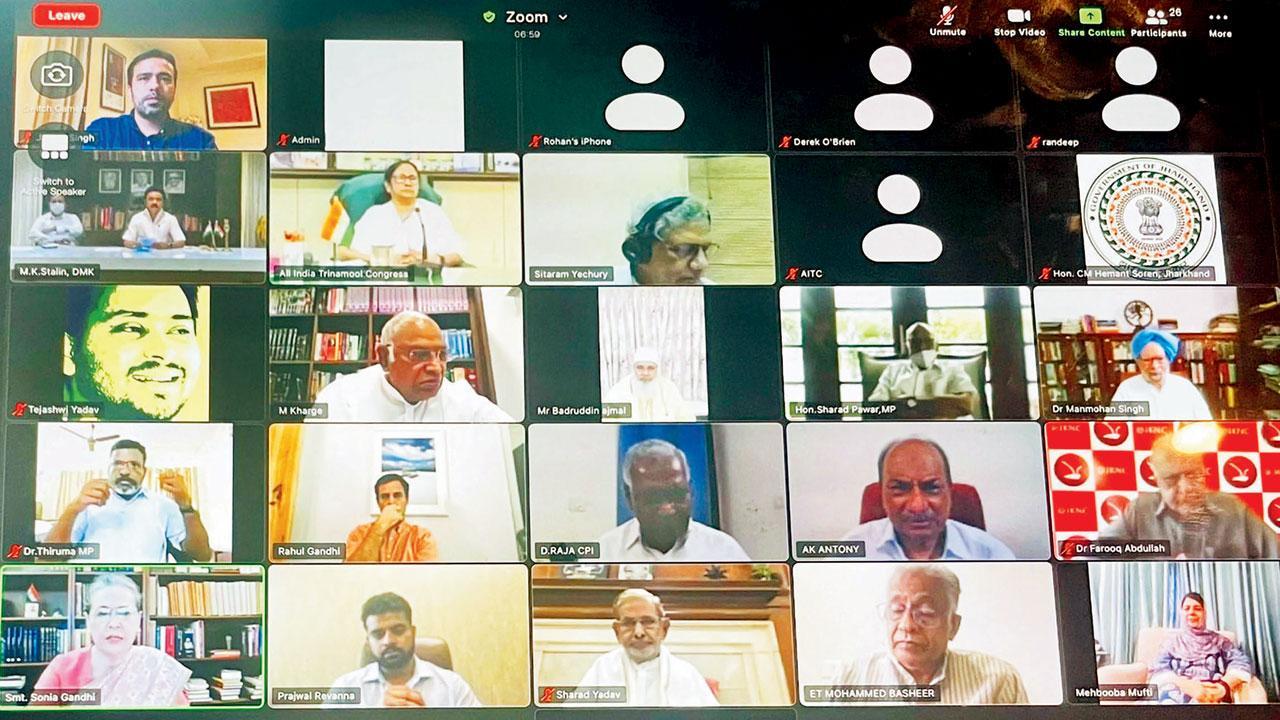The Congress president is trying to convince like-minded political parties to be part of a team which could be an alternative to the BJP

Opposition parties’ leaders attend an online meeting called by Congress President Sonia Gandhi, on August 20. Pic/PTI
People may say what Congress president Sonia Gandhi is trying to do is akin to the late Jai Prakash Narayan’s attempt against her mother-in-law, the late Indira Gandhi, four decades ago. Friday’s kick-off saw 19 non-BJP parties resolving to go united against the Modi rule. The group expects to widen its net and get in more parties to join them by next general elections. The realisation of Sonia’s JP-like dream will depend on the mighty regional players, who, according to the Congress president, should rise above their political compulsions. Will the unwilling be convinced into being part of the team that proposes to offer an alternative to the BJP in next three years?
But before they could expand into a bigger and cohesive unit to take the fight straight into the BJP citadel, difference of opinion surfaced over the leadership of the front. Mamata Banerjee, who is averse to the idea of her former party (the Congress) taking charge of the movement, doesn’t want a group leader identified, especially when the initiative Sonia has taken and the response evoked puts the former UPA chief in a top position. Instead, Mamata wants a core group to decide the course. She suggested that the parties that fight against the Congress (her All India Trinamool Congress is one of them) be invited to fight the Bharatiya Janata Party (BJP). Her statement could be linked to the Aam Aadmi Party and others, who weren’t invited to the Congress president-led virtual meeting. Regional rivals, the Bahujan Samaj Party and Samajwadi Party, who, along with the Congress and BJP, complete a four-party set-up in Uttar Pradesh, did not attend, apparently because of the upcoming Assembly elections.
ADVERTISEMENT
Major regional players down the south-eastern coast, considered neutral or pro-BJP while not being allied, have kept their distance from the action group. Their participation in the future, active or passive, will be determined by how the BJP handles them. Consider, on the west coast, BJP’s former ally in Maharashtra, Shiv Sena, which was represented by Maharashtra Chief Minister Uddhav Thackeray on Friday. The Sena broke up with the BJP after winning a majority to form the government because it wanted to share the CM’s office. It unseated the frenemy by having a tripartite arrangement with the Congress and Nationalist Congress Party. And now, the Sena is expected to carry forward the arrangement till 2024 and even beyond. Will it or will it not? The question will pop up much later. For now, the Sena has joined the anti-BJP forces at national level.
It is said that Rahul Gandhi, who was seen in a new avatar in the recent Parliamentary session, worked hard on the Sena. Rahul’s bonhomie is seen as an assurance for the Maha Vikas Aghadi government’s unaffected run despite his reluctance to collaborate with the Sena in 2019. Two years later, senior Congressmen believe that the Congress-Shiv Sena pact, in case the Sharad Pawar-led NCP gets lured away, could work even better in Maharashtra’s electoral politics. But they say the bond would work only when the Sena closes all roads leading to the BJP. The Sena insiders say that the induction of Narayan Rane in the Union cabinet has increased manifold the party leadership’s bitterness for the BJP’s high command.
Unlike the Sena, some other former NDA partners seem to have some reservations over pledging support, perhaps because their participation could be detrimental to their regional interests. The united opposition’s picture will be fairly clear after the next year’s Assembly elections in UP, Punjab, Gujarat, Uttarakhand, Himachal Pradesh, Manipur and Goa. A year later, nine states will have Assembly elections. It will be followed by the Lok Sabha elections in the summer of 2024, the year which will also have seven state elections split between the summer and winter. So, the 16 states going to polls in 2022 and 2023 will be key to the opposition’s 2024 campaign against the BJP, which will be working on dismantling the unity of the opposition. Apart from the ruling party they are up in arms against, the opposition will be faced with the past experiences of such complex formations and the learning from the JP experiment which succeeded but did not last long. To achieve success — we can’t predict its size at this stage — the opposition will need honesty from the participants to make the people believe that “we are the alternative that you must vote for”. In her address on Friday, Sonia Gandhi gave a sense of reality in a virtual meeting, when she said, “This is a challenge, but together we can and must rise to it because there is simply no alternative to working cohesively together.”
Dharmendra Jore is political editor, mid-day. He tweets@dharmendrajore
Send your feedback to mailbag@mid-day.com
 Subscribe today by clicking the link and stay updated with the latest news!" Click here!
Subscribe today by clicking the link and stay updated with the latest news!" Click here!







